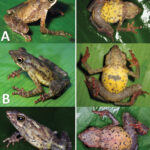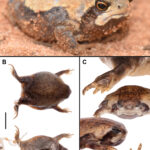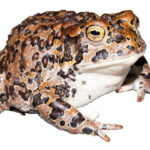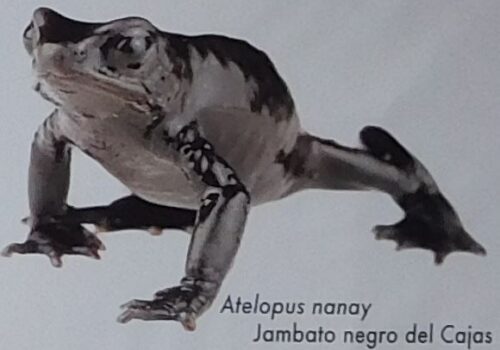- Atelopus Nepiozomus: Discovering Ecuador's Enigmatic Harlequin Frog
- Introduction: An Elusive Jewel of the Cloud Forest
- Taxonomy and Classification: Placing Atelopus Nepiozomus in Context
- Natural Habitat: Life Where Clouds Embrace the Mountainside
- Physical Characteristics: Vibrant Beauty with a Purpose
- Behavior and Life Cycle: Stories Written in Streams and Mossy Pools
- Ecological Role: Essential Indicators of Environmental Health
- Threats and Conservation Status: Facing the Tide of Environmental Change
- Cultural and Scientific Significance: A Symbol of Ecuadorian Biodiversity
- Conclusion: Embracing Responsibility for Our Natural Heritage
Atelopus Nepiozomus: Discovering Ecuador’s Enigmatic Harlequin Frog#
Introduction: An Elusive Jewel of the Cloud Forest#
Deep within the mist-covered Andean forests, among emerald ferns and gently trickling streams, dwells a creature as captivating as it is elusive: the Harlequin frog known scientifically as Atelopus nepiozomus. This striking amphibian represents one of nature’s most colorful enigmas—vividly patterned yet seldom encountered. While it might be inconspicuous at first glance against the mossy backdrop of its natural habitat, once noticed, its vibrant colors and unique biology beckon curiosity, admiration, and a deep sense of conservation urgency.
The very existence of Atelopus nepiozomus serves as a reflection of environmental health in its mountainous home, placing it at the forefront of conservation efforts and ecological research. Characterized by dazzling colors and intriguing behaviors, this frog is more than a biological curiosity; it symbolizes the breathtaking beauty—and fragility—of its ecosystem. However, despite its charm and ecological significance, the frog remains poorly understood and increasingly rare.
Unraveling the story of this extraordinary amphibian is an opportunity to journey deep into one of Earth’s richest biodiversity hotspots, to uncover secrets guarded by dense vegetation and swirling clouds, and to glimpse one species’ unique adaptations through millions of years of evolutionary history.
Taxonomy and Classification: Placing Atelopus Nepiozomus in Context#
The remarkable species Atelopus nepiozomus belongs to the Bufonidae family, commonly known as the true toads, within the genus Atelopus—a remarkable group often called Harlequin frogs. Despite their common name, Harlequin frogs are in fact true toads, yet unlike their more familiar lowland relatives, they exhibit streamlined bodies and brilliant, contrasting colors far removed from the drab coloration most people associate with toad species.
Identified and classified formally by Peters in 1973, this species belongs to an extensive genus known for its extreme sensitivity to environmental changes and remarkable adaptability to high elevations. The Harlequin frogs’ stark coloration warns potential predators of toxins present in their skin, a trait they’ve evolved to survive in ecologically competitive environments. Closely related species in the genus Atelopus have similarly striking colors and share similar threats, highlighting the broader importance and fragile status of the whole group.
Natural Habitat: Life Where Clouds Embrace the Mountainside#
Found exclusively in Ecuador, particularly in cloud forest regions along Andean slopes, Atelopus nepiozomus inhabits one of the planet’s most biodiverse hotspots. The wet, mist-covered cloud forests hosting this species are located typically between 800 and 2000 meters above sea level, an environment perpetually bathed in moisture and shielded by trees draped generously with mosses, orchids, and bromeliads.
These amphibians depend intimately on clear, shallow streams and cool temperatures, making the availability and purity of freshwater a critical component in their lives. Rocks covered in algae and lichens, leaf litter, and dense undergrowth offer essential microhabitats. Fluctuating temperatures, near-constant humidity, and the varied vertical structure of these forests collectively create the ideal conditions for the frogs’ delicate skin and specialized survival strategies.
This careful harmony between species and environment has evolved over countless millennia, resulting in intricate adaptations—each playing a central role in the frog’s delicate balance of existence within the ecosystem. Their presence becomes a reflection of the intricately woven Andean web of life.
Physical Characteristics: Vibrant Beauty with a Purpose#
When lucky enough to see one, perhaps nestled on a slick, moss-covered stone near flowing water, the dazzling appearance of Atelopus nepiozomus stops even a keen naturalist in their tracks. Small in stature, usually measuring less than three centimeters from snout to tail, the species nevertheless commands attention with its bold, unmistakable coloration.
Its dorsal surfaces boast vivid combinations of shades: bright oranges, yellows, greens, and black markings, forming intricate, almost artistic designs. Though this coloration might initially seem counterproductive for survival, in actuality, it’s a sophisticated survival strategy. Known as aposematic (warning) coloration, this conspicuous blend announces to potential predators that the frog carries toxins powerful enough to discourage further investigation.
The frog’s smooth, slightly damp skin is permeable and has adapted to the humid atmosphere of their environment, facilitating moisture regulation and respiration. Strong, elongated hind legs grant them excellent mobility throughout their slippery habitat, while small but adhesive pads at their fingertips enable precision in leaping and climbing. These adaptations not only demonstrate exquisite evolutionary artistry but afford the species survival advantages within their challenging natural environment.
Behavior and Life Cycle: Stories Written in Streams and Mossy Pools#
The daily life and behavioral habits of Atelopus nepiozomus are intricately matched with their surroundings. Largely diurnal, these frogs are active during daylight when they’re seen feeding on small invertebrates—ants, beetles, and other terrestrial insects—patiently waiting alongside forest trails or stream banks for prey to cross their paths.
Mating Rituals and Breeding Habits#
The reproductive cycle of these frogs marks a key event in their annual existence. The mating season typically aligns with periods of heavy precipitation, when their mountain home is abundantly replenished with rainfall. During these times, males occupy strategic points along creek beds, calling with subtle yet persistent chirps to attract females while simultaneously dissuading competing males.
After successful pairing, fertilized eggs are deposited into shallow pools and slow-flowing streams where tadpoles rapidly develop. Unlike some other amphibians, minimal parental care is exhibited by adult Atelopus, trusting instead their breeding habitat provides sufficient protection and sustenance to young larvae. The tadpoles mature quickly, undergoing metamorphosis into miniature versions of their vibrantly colored parents—ready to take on complex Andean ecosystems within a matter of weeks.
Ecological Role: Essential Indicators of Environmental Health#
The position of Atelopus nepiozomus in its ecosystem highlights a crucial interdependency. As insectivores, these frogs help control the populations of various insects, maintaining balance within the food web. Conversely, despite their toxic skin defenses, they inadvertently serve as prey for larger predators immune or tolerant to their potency, including certain snakes and specialized birds adapted to mountain environments.
Perhaps most importantly, these frogs serve as living “bioindicators”—species whose population health provides early warnings of broader environmental challenges. Sensitive to pollution, disturbance, and climatic fluctuations, declines or disturbances in their populations signal deeper ecological issues, prompting researchers and conservationists to action.
Threats and Conservation Status: Facing the Tide of Environmental Change#
Sadly, today this once widely thriving species exists on the brink, listed as Critically Endangered by the International Union for Conservation of Nature (IUCN). Habitat loss due to agriculture, mining, and logging, alongside pollution and the global climate crisis, has fragmented populations severely. Most alarmingly, widespread outbreaks of chytridiomycosis—a fungal disease catastrophic to amphibians—are devastating Andean amphibian communities, including harlequin frogs.
Urgent conservation initiatives have emerged in response—field surveys, captive breeding projects, habitat restoration efforts, and disease management programs. A cautious hope lingers in the efforts that aim to reclaim vital habitats and combat ecological threats, raising awareness worldwide regarding the frog’s bleak survival prospects and the importance of ecosystem protection.
Cultural and Scientific Significance: A Symbol of Ecuadorian Biodiversity#
Atelopus nepiozomus subtly enriches Ecuadorian cultural heritage as a symbol showcasing the country’s astounding ecological diversity. Indigenous communities living within its range often recognize its role, holding frogs as significant characters in stories reflecting nature’s wisdom and balance.
From a scientific perspective, insights learned from studying this frog present crucial understandings relevant to climate change impacts, toxin chemistry, disease ecology, and evolutionary patterns of behavior—valuable knowledge pointing toward broader environmental stewardship.
Conclusion: Embracing Responsibility for Our Natural Heritage#
In uncovering Atelopus nepiozomus‘ story, we forge a deeper connection between humanity’s fate and the health of the natural world around us. Protecting this enigmatic amphibian not only safeguards a vibrant fragment of Earth’s diversity but signals our collective commitment towards mindful coexistence with nature. Every reader has the power, through advocacy, education, and conservation support, to make a difference—preserving spectacular creatures like this one for generations to admire, study, and cherish.








